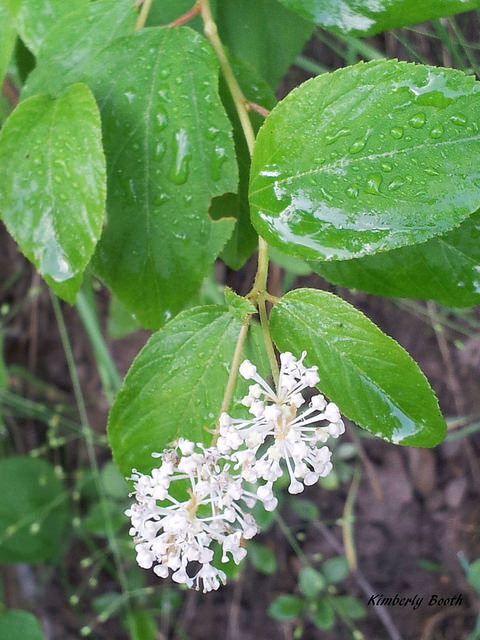Map Snapshot










55 Records
Status
Native to eastern and central North America. Leaves were used as a substitute for tea during the Revolutionary War.
Description
A bushy shrub to 3 feet tall. Leaves ovate. Flowers in clusters at the tips of axillary, nearly leafless, herbaceous branches.
Where To Find
More common in the mountains and Piedmont than on the Coastal Plain. Grows in dry soils, either in the open or in light shade.
Relationships
Host plant for Mottled Skipper.
Host plant for various moth species including Ancylis semiovana (Gilligan, Wright, & Gibson, 2008).
Seasonality Snapshot
Source: Wikipedia
| New Jersey tea | |
|---|---|

| |
| Scientific classification | |
| Kingdom: | Plantae |
| Clade: | Tracheophytes |
| Clade: | Angiosperms |
| Clade: | Eudicots |
| Clade: | Rosids |
| Order: | Rosales |
| Family: | Rhamnaceae |
| Genus: | Ceanothus |
| Species: | C. americanus
|
| Binomial name | |
| Ceanothus americanus | |
| Synonyms[4][5][6][7][8][9] | |
Ceanothus americanus is a species of Ceanothus shrub native to North America. Common names include New Jersey tea, Jersey tea ceanothus, variations of red root (red-root; redroot), mountain sweet (mountain-sweet; mountainsweet), and wild snowball.[3][5] New Jersey tea was a name coined during the American Revolution, because its leaves were used as a substitute for imported tea.[4]
Description
[edit]Ceanothus americanus is a shrub that lives up to fifteen years[1] and growing between 18 and 42 in (0.5 and 1 m) high, having many thin branches. Its root system is thick with fibrous root hairs close to the surface, but with stout, burlish, woody roots that reach deep into the earth—root systems may grow very large in the wild, to compensate after repeated exposures to wildfires. White flowers grow in clumpy inflorescences on lengthy, axillary peduncles. Fruits are dry, dehiscent, seed capsules.[4][additional citation(s) needed]
Habitat
[edit]Ceanothus americanus is common on dry plains, prairies, or similar untreed areas, on soils that are sandy or rocky. It can often be located in forest clearings or verges, on banks or lakeshores, and on gentle slopes.[4]
Distribution
[edit]Ceanothus americanus is found in Canada, in Ontario and Quebec. In the U.S., it is found in Alabama; Arkansas; Connecticut; Delaware; northern and central Florida; Georgia; Illinois; Indiana; Iowa; Kansas; Louisiana; Maine (in Oxford and Penobscot counties); Maryland; Massachusetts; Michigan; Minnesota; Mississippi; Missouri; Nebraska; New Hampshire; New Jersey; New York; North and South Carolina; Ohio; Oklahoma; Pennsylvania; Rhode Island; eastern and central Texas; Vermont; West Virginia; Wisconsin; and Virginia[5]
Ecology
[edit]During winter in the Ozarks of Missouri, its twigs are sought as food by the local deer; and white-tailed deer (Odocoileus virginianus), in particular, will browse C. americanus year round.[4]
The flowers of C. americanus are used as food by (and the shoots host the larvae of) butterflies in the genus Celastrina, including spring azure, and summer azure; and by Erynnis martialis (mottled duskywing)[10] and Erynnis icelus (dreamy duskywing).
Ceanothus americanus seeds are consumed by wild turkeys and quail.[10]
Constituents and medicinal use
[edit]The red roots and root bark of New Jersey tea are used by Native Americans in North America for infections of the upper respiratory tract. The leaves have a fresh scent of wintergreen and were later utilized by the European colonizers as a tea substitute and stimulating caffeine-free beverage. The root bark of the plant is used by herbalists today, and are used notably in remedies for problems of the lymph system. The root contains astringent tannins and a number of peptide alkaloids, including ceanothine A-E, pandamine, zizyphine, scutianine, and the adouetines.[11] They have a mild hypotensive effect.[11] Root and flower extracts can also be used as dyes.[12]
References
[edit]- ^ "NatureServe Explorer 2.0". explorer.natureserve.org.
- ^ C. americanus was first described and published in Species Plantarum 1: 195. 1753. "Plant Name Details for Ceanothus americanus". IPNI. Retrieved August 16, 2010.
Distribution: Virginia, Carolina, United States of America (Northern America).
- ^ a b "Ceanothus americanus L.". Tropicos. Missouri Botanical Garden. Retrieved August 16, 2010.
- ^ a b c d e Coladonato, Milo (1993). "Ceanothus americanus". Fire Effects Information System (FEIS). US Department of Agriculture (USDA), Forest Service (USFS), Rocky Mountain Research Station, Fire Sciences Laboratory. Retrieved August 16, 2010.
- ^ a b c "Ceanothus americanus". Germplasm Resources Information Network. Agricultural Research Service, United States Department of Agriculture. Retrieved August 16, 2010.
- ^ C. americanus var. intermedius was published in A Flora of North America, 1(2): 264. 1838.
"Ceanothus americanus var. intermedius (Pursh) Torr. & A.Gray". Tropicos. Missouri Botanical Garden. Retrieved August 16, 2010. - ^ C. americanus var. pitcheri was published in A Flora of North America, 1(2): 264. 1838.
"Ceanothus americanus var. pitcheri Torr. & A.Gray". Tropicos. Missouri Botanical Garden. Retrieved August 16, 2010. - ^ C. intermedius was published in Flora Americae Septentrionalis. ... 1: 167. 1814.
"Ceanothus intermedius Pursh". Tropicos. Missouri Botanical Garden. Retrieved August 16, 2010. - ^ C. ovatus was published in Histoire des Arbres et Arbrisseaux qui peuvent etre cultives en pleine terre sur le sol de la France, 2: 381. 1809. Paris. Harvard University Herbaria/Arnold Arboretum (April 7, 2008). "Botanical Specimen Search Results for Ceanothus ovatus". Index of Botanical Specimens. President and Fellows of Harvard College. Retrieved August 16, 2010.
- ^ a b "Ceanothus americanus". Native Plant Database. Lady Bird Johnson Wildflower Center, University of Texas at Austin. Retrieved August 16, 2010.
- ^ a b J.E. Saxton ed. "The Alkaloids". A special report. Vol I The Chemical Society Burlington House, London (1971) SBN 85186 257 8
- ^ "Ceanothus americanus". Plants for a Future. Retrieved April 25, 2013.
External links
[edit] Media related to Ceanothus americanus at Wikimedia Commons
Media related to Ceanothus americanus at Wikimedia Commons















